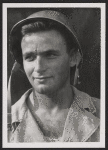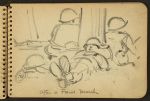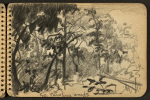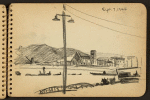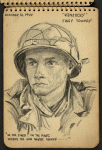Collection Overviews
World War II Sketches by Victor A. LundyPrints and Photographs DivisionCollection digitized? Yes. See Access section below. Overview | Access | Related Resources | Checklist Overview
"August 25th 1944, there's a sketch which says 'overseas at last,' and since then, I realized we were part of a very significant occasion.... this is real." A visual diary with 158 pencil sketches brings to life the wartime experience of noted architect Victor A. Lundy, who served in the U.S. 26th Infantry Division during World War II. In 1942, Lundy was 19, studying to be an architect in New York City. Excited about rebuilding Europe post-war, he and other college men enlisted in the Army Special Training Program (ASTP). But, by 1944, with D-Day planned, the Army needed reinforcements, and Lundy and his company were thrown into the infantry. Lundy couldn't believe it and recalled during an oral history interview that during lectures, he "never listened, I was busy sketching." But soon, "I sort of took to it. ... war experience just hypnotizes young men."
Lundy applied his drawing skills to what was around him--training at Fort Jackson, South Carolina; forced marches; men at rest; the PX and tents; New York harbor; aboard ship in the Atlantic crossing; Cherbourg harbor; and French villages. Many vivid portraits of fellow soldiers and frontline danger also fill the pages. The sketches cover May to November 1944 when Lundy was wounded, with some gaps where notebooks were lost. The eight surviving sketchbooks are spiral bound and 3 x 5 inches --small enough to fit in a breast pocket. Lundy used black Hardtmuth leads (a drawing pencil) and sketched quickly. "For me, drawing is sort of synonymous with thinking." Victor Alfred Lundy was born in 1923 in New York City. After serving in the U.S. Army during World War II, he completed a degree in architecture at the Harvard University Graduate School of Design. Winning the prestigious Rotch Travelling Scholarship allowed him to travel abroad. In 1954, Lundy opened an architectural firm in Sarasota, Florida. In 1967, the American Institute of Architects named him a Fellow--one of its highest honors. Lundy moved to Houston, Texas, in the 1970s. Among the notable buildings designed by this master artist-architect are churches with soaring roof lines, the Sarasota Chamber of Commerce, the U.S. Tax Court, and the U.S. Embassy in Sri Lanka. Lundy is donating his architectural archive to the Library of Congress, including these World War II sketchbooks presented in 2009. Access
Digital images created in 2010 provide ready reference viewing copies in the Prints & Photographs Online Catalog. A catalog record accompanies each image. Original sketchbooks are served by appointment only, because they require special handling. For more information, see: http://www.loc.gov/rr/print/info/617_apptonly.html Obtaining ReproductionsUsers can download images themselves or can purchase copies through the Library of Congress Duplication Services. The images have been scanned at a resolution that is sufficient for most publication purposes. Duplication Services makes reproductions from the digital files, rather than from the original drawings. Rights Information and Credit LineThere are no known restrictions on the publication of images from these sketchbooks. Credit line: Library of Congress, Prints & Photographs Division, World War Two sketches by Victor Lundy, [reproduction number, e.g., LC-DIG-ppmsca-23970] Related Resources
Lundy, Victor A. "Beyond the Harvard Box," video interview, Lundy studio, Houston, Texas, 2006, http://www.gsd.harvard.edu/events/exhibitions/Harvard_Box/victorlundy.mov Sugarman, Tracy A. World War II drawings in "Experiencing War," Library of Congress, Veterans History Project, http://lcweb2.loc.gov/diglib/vhp/story/loc.natlib.afc2001001.05440/ Veterans History Project, Library of Congress, http://www.loc.gov/vets/ ChecklistIn 2010, Victor Lundy looked through the sketchbook images and commented on the drawings during an oral history interview with Library staff. Volume 1: 1944 Spring, Fort Jackson, South Carolina (19 sketches in LOT 14007-1)
Volume 2: 1944 Spring, Fort Jackson, South Carolina (23 sketches in LOT 14007-2)
Volume 3: 1944 Summer, Fort Jackson, South Carolina (22 sketches in LOT 14007-3)
Volume 4: 1944 August. En route to Europe (20 sketches in LOT 14007-4)
Volume 5: 1944 August-September. En route to Europe (18 sketches in LOT 14007-5)
Volume 6: 1944 August-September, France (25 sketches in LOT 14007-6)
Volume 7: 1944 September, France (26 sketches in LOT 14007-7)
Volume 8: 1944 Sept. to November, France (5 sketches in LOT 14007-8)
Prepared by: Karen Chittenden, Cataloging Specialist, and Sarah Rouse, May 2010. |
||||||||||||||||||
Collection Overviews
| The
Library of Congress >> Researchers March 16, 2012 |
Legal | External Link Disclaimer |
Contact
Us: Ask a Librarian |

